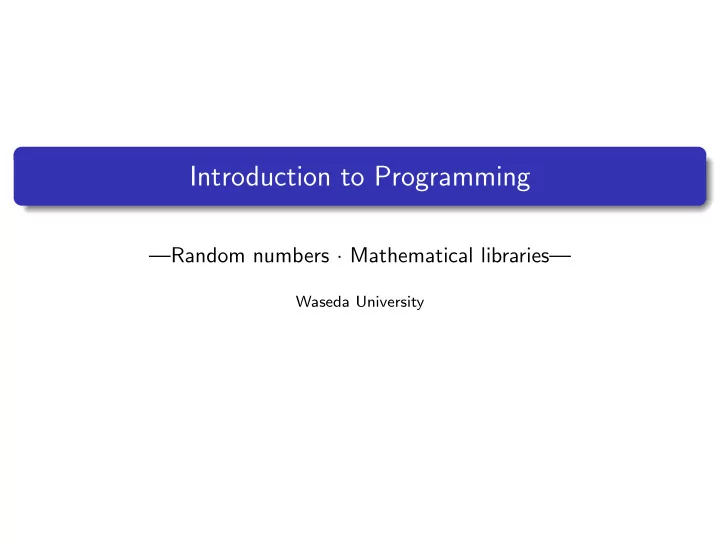

Introduction to Programming —Random numbers · Mathematical libraries— Waseda University
Today’s topics How to use pseudorandom numbers. #include Initialization Random integer numbers Random real numbers How to use mathematical libraries. Mathematical function, mathematical constants How to compile with math.h (gcc filename -lm)
Include of header file ( #include ) We have described ” #include < stdio.h > ” at the beginning of our programs. This loads the file in order to use ”printf” and ”scanf” functions. In the C Programming Language, files called ”standard header files” containing functions are set up. According to the function used in the program, it is necessary to include the standard header files. The main standard header files are the following: stdio.h: printf, scanf and so on (Input/Output) stdlib.h: rand, srand, exit, malloc and so on math.h: exp, sqrt, sin, cos and so on (Mathematical function) string.h: strcpy, strlen and so on (String manipulations) time.h time and so on (Time manipulations)
Pseudorandom numbers Usage of pseudorandom numbers in a program. ✓ ✏ What’s random numbers? Random numbers are a sequence of numbers that are arranged so that each number appears in completely the same process In C Programming Language, random numbers are generated with ”rand” function. However, ”rand” returns a number that doesn’t occur in exactly the same process as a random number, known as a pseudorandom number. ”rand” function generates random numbers based on a certain value. Therefore, if the initial value is the same then the exact same sequence of random numbers will appear. ✒ ✑
Pseudorandom numbers How to generate: including time.h and stdlib.h #include <time.h> /* Time manipulations functions*/ #include <stdlib.h> /*rand functions*/ Initialization of random numbers according to current time srand((unsigned)time(NULL)); /* Initialization of rand */ If you want to have the same sequence of numbers, specify a fixed value like ”srand (integer value)”. For example, ”srand(56);”
Pseudorandom numbers (Regularity remains) rand() returns a random integer value from 0 to RAND MAX a = rand(); (RAND _ MAX is a compiler-dependent constant) The following returns a random real value from 0 to 1 a = rand()/ (RAND_MAX +1.0); The following returns a random integer value from 0 to N a = (int) (rand()/(RAND_MAX +1.0)*N);
Example of Pseudorandom ✓ ✏ Dice ( dice.c ) #include <stdio.h> #include <time.h> #include <stdlib.h> int main(void){ int a; srand((unsigned) time(NULL)); a = (int) (rand()/(RAND_MAX+1.0)*6); printf("Result is %d. Yn", a+1); return 0; } ✒ ✑ ⇒ you generate random integer numbers that are ”greater than or equal to 0 and less than 6” first. Then you add 1 to the numbers when the numbers are displayed.
Example 1 Write a program to display today’s fortune This program will display a message with probability in the table. Probability 30% 60 % 10 % Message Very lucky lucky Not lucky When you finish writing the source code and successfully compile it, execute the file several times and confirm that it works roughly according to probability. Regarding the ”time” used to initialize random numbers, the time function returns the time measured in seconds from UTC If you want to display the results in days, write the source code as shown the following: srand((unsigned)time(NULL)/(60*60*24));
Hint of example 1 Don’t forget to include header file and initialize random numbers. Use if statement in order to determine the branches: if(a<0.3) printf("...") else if(a<0.9) printf("...") else printf("...")
Mathematical libraries You can use mathematical functions and constants (for examples, sin , log , π and so on) in the program including math.h. How to use mathematical functions and constants 1 You include header files as the following: #include <math.h> 2 Remember to put ”-lm” when compiling the file. $ gcc filename -lm Without this, an error will occur. 3 This example is written using ”10 natural logarithms”: a= log(10.0);
Mathematical libraries Mathematical functions How to use Meaning How to use Meaning fabs(x) Absolute exp(x) Exponential log(x) Natural logarithm log10(x) Common logarithm pow(x,y) x to the power of y sqrt(x) Square root cos(x) cos acos(x) arccos sin(x) sin asin(x) arcsin tan(x) tan atan(x) arctan atan2(y,x) arctan( y/x ) cosh(x) cosh sinh(x) sinh tanh(x) tanh floor(x) The largest integer not greater than x ceil(x) The smallest integer not less than x Mathematical constants How to use Meaning How to use Meaning π Square root of 2 M_PI M_SQRT2 M_E e M_LN10 log e 10
Example 2 Example 2: Write a program to calculate the integrated value by using random numbers: How to calculate Repeat generating of random numbers ( x, y ) which are ”greater than or equal to 0 less than 1” depending on the inputted value. Calculate the ratio ”r” that satisfies y < sin( πx ) . ∫ 1 sin πx = 2 This ratio will converge at π . 0 Display the value ”r” and Error for 2 /π . For example: How many trials? 1000 【 Enter 】 Result is 0.652000 (Error: -0.015380)
Hints of example 2 Don’t forget to include header files (time.h,stdlib.h,math.h). Don’t forget to put ”-lm” when compiling the file. This question uses the x and y axis of coordinate on a 1x1 square. Points are spread in the square and we will calculate how many points are inside of the curve (the shaded area in the figure). The ratio : Number of points satisfying the conditions Number of all points Use an int type variable for counting numbers of points. Note that you use cast operator when you calculate the ratio. 1 0 1
Summary How to use pseudorandom numbers. #include Initialization Random integer numbers Random real numbers How to use mathematical libraries. Mathematical function, mathematical constants How to compile with math.h (gcc filename -lm)
Recommend
More recommend